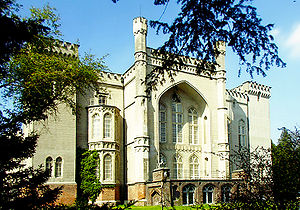
Kórnik Castle
Encyclopedia

Kórnik
Kórnik is a town with about 6,800 inhabitants , located in western Poland, approximately south-east of the city of Poznań. It is one of the major tourist attractions of the Wielkopolska region....
Castle was constructed in the 14th century. The current neogothic design is the work of Tytus Działyński. Remodeling and renovation work on the castle was also done by his son Jan Kanty Działyński. After Jan's death, his brother-in-law Count Władysław Zamoyski received the castle in Jan's will. Shortly before his death in 1924, the childless count willed the castle, along with an extensive art collection and the Kórnik Arboretum
Kórnik Arboretum
The Kórnik Arboretum is the largest and oldest Polish arboretum. It was stablished in the early 19th century around the historical Kórnik Castle by its owner, Count Tytus Działyński, later enriched with new species and varieties by his heirs: his son Jan Kanty Działyński and Władysław Zamoyski.The...
to the Polish state. The castle currently houses a museum and the Kórnik Library
Kórnik Library
Kórnik Library is one of the most famous Polish libraries, founded by Tytus Działyński in 1828 at Kórnik. Currently the library, despite being robbed by the Germans during World War II, is one of the five largest libraries in Poland and contains roughly 400,000 volumes, including 30,000 books...
.

